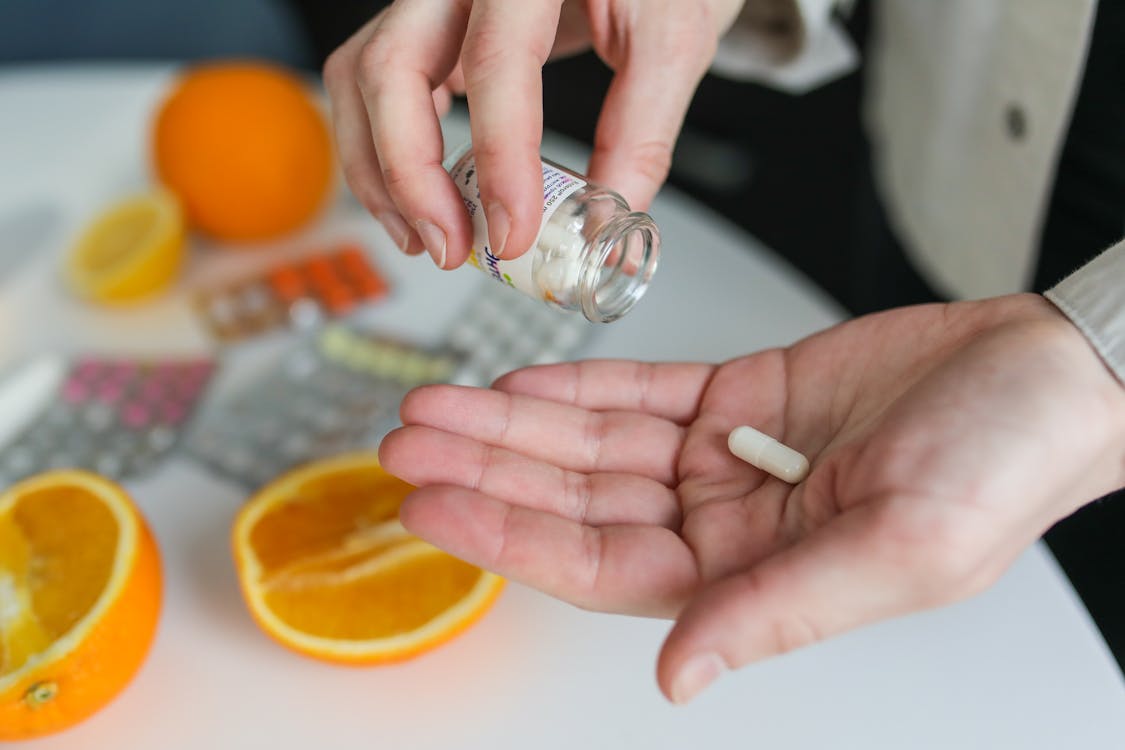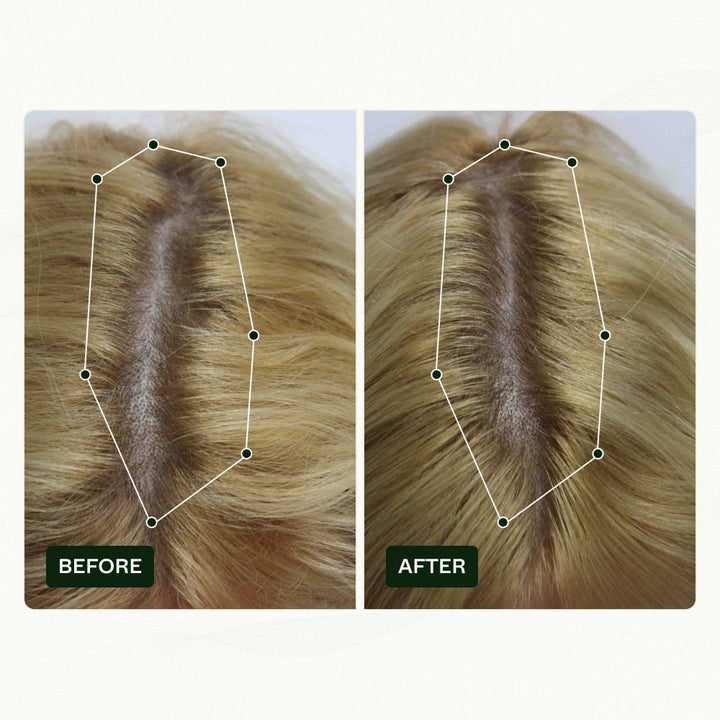Are you seeking effective solutions for hair loss? Topical Spironolactone might be the breakthrough you need.
This article explores the benefits and mechanisms of how Topical Spironolactone works to combat hair loss, offering insight into its potential as a game-changer for those struggling with thinning hair.
Discover how this treatment can revitalize your hair growth journey, providing hope and results for individuals facing hair loss challenges.
Table of content
What is spironolactone?

Spironolactone is a medication primarily used as a diuretic and antihypertensive agent, but it also has anti-androgen effects. It works by blocking the action of aldosterone in the kidneys, which leads to the removal of excess water and salt from the body through urine.
Its anti-androgen properties make it useful for treating conditions like hormonal acne, hirsutism (excessive hair growth), and it is investigated for its efficacy in treating hair loss, particularly in cases linked to hormonal imbalances.
As your leading source for hair health information over the past 4 years, we never compromise on accuracy. When it comes to your health, you deserve information you can truly rely on - and earning your trust is our top priority.
Here's how Scandinavian Biolabs ensures every piece of content meets the highest standards of accuracy and integrity:
- Credentialed Experts: Our reviewers are actively practicing doctors and medical researchers
- Stringent Reviews: Content undergoes rigorous editing by subject specialists and review by a practicing doctor.
- Evidence-Based: We rely on well-established research from trusted scientific sources like peer-reviewed journals and health authorities.
- Full Transparency: Our editorial standards, writer credentials, reviewer credentials, correction process, and funding are all publicly documented.
- Independent Voice: While we do promote products, we operate in a vacuum to business operations. Our main goal is just an unwavering commitment to providing medically-sound guidance.
You can count on Scandinavian Biolabs to consistently deliver the trustworthy health information you deserve. Read our Editorial Standards.
How does spironolactone treat hair loss?
Spironolactone treats hair loss by acting as an anti-androgen, blocking the effects of male hormones that can contribute to hair loss in women, particularly in conditions like female pattern hair loss (FPHL) and androgenetic alopecia. Clinical studies and research have supported the efficacy of spironolactone in treating hair loss.
For instance, a study published in the "Journal of the American Academy of Dermatology" found that spironolactone can be an effective treatment for female pattern hair loss, with many patients experiencing a reduction in hair shedding and an increase in hair density.
Given the complex nature of hair loss and the various factors that can contribute to it, spironolactone offers a targeted approach by addressing the hormonal component, particularly in premenopausal women.
It is now widely recognized as a key treatment option, with its off-label use for hair loss becoming increasingly common in the United States.
Who can use spironolactone?
Spironolactone is suitable for most non-pregnant women dealing with hormonal-related hair loss. However, due to its antiandrogenic and potentially teratogenic properties, it is not recommended for pregnant women, those planning to become pregnant, or breastfeeding mothers.
Users should have a birth control plan in place while on spironolactone to avoid potential fetal risks.
What is the recommended dosage for spironolactone?
The recommended dosage of spironolactone for hair loss typically ranges from 100 to 200 milligrams daily, depending on individual conditions and the healthcare provider's assessment. Recent studies suggest that 200 milligrams per day can be effective in either promoting hair growth or preventing further hair loss.
However, dosages can vary widely, with some patients seeing improvements on doses as low as 25 milligrams daily and up to 200 milligrams.
For optimal results, especially in cases of female pattern hair loss, combining spironolactone with other treatments like minoxidil has shown to enhance efficacy.
Oral spironolactone vs topical spironolactone: What are the differences?

Oral spironolactone is taken by mouth and affects the entire body, while topical spironolactone is applied directly to the skin or scalp, targeting specific areas with potentially fewer systemic side effects. Let’s look at more differences:
Absorption and distribution
Oral Spironolactone is absorbed through the digestive system, distributing its effects across the entire body, including systemic hormonal regulation which impacts hair follicles among other tissues.
This widespread distribution means it can address hormonal imbalances more globally, which is beneficial for conditions influenced by the body's overall hormonal state.
Topical Spironolactone, in contrast, is applied directly onto the skin or scalp, allowing for a concentrated effect at the site of application with minimal systemic absorption.
This localized approach means that the medication acts primarily where it is needed, reducing the potential for systemic side effects and directly targeting hair follicles to prevent or reduce hair loss.
Side effects
Oral Spironolactone can lead to more systemic side effects, such as electrolyte imbalances, dehydration, and potentially impacting kidney function, due to its diuretic and hormonal effects throughout the body. Women of childbearing age also need to be cautious due to its teratogenic potential.
On the other hand, topical Spironolactone tends to have fewer and milder side effects, primarily localized to the area of application. Since it does not enter the bloodstream in significant amounts, the risk of systemic side effects is greatly reduced, making it a safer option for those concerned about the broader impacts of oral medication.
Efficacy for hair loss
Oral Spironolactone's systemic action can be highly effective for treating hair loss that is due to hormonal imbalances, as it allows for the adjustment of hormone levels throughout the body. Its ability to reduce the production of androgens makes it a potent option for conditions like female pattern hair loss and androgenetic alopecia.
Topical Spironolactone acts directly on the hair follicles, which can be beneficial for those looking to address hair loss without altering their body's overall hormonal balance.
While it may be particularly useful for localized treatment, its efficacy can be limited compared to oral spironolactone, which addresses the hormonal root causes of hair loss more comprehensively.
Suitability and use
Oral Spironolactone is suitable for individuals with conditions that are influenced by systemic hormonal levels, including various forms of hair loss, acne, and hirsutism. It requires monitoring by a healthcare provider due to the potential for significant side effects and interactions with other medications.
Topical Spironolactone is ideal for those who prefer a treatment with fewer systemic effects or who may be concerned about the side effects of oral medication. It is also useful for targeting hair loss more directly, with a simpler application process that focuses on the scalp or affected areas.
Convenience and compliance
Taking Oral Spironolactone involves daily oral intake, usually one or two times per day, which can be easily incorporated into most routines.
However, the need for ongoing monitoring and the potential for side effects may affect long-term compliance.
Topical Spironolactone requires regular application to the affected area, which might be less convenient for some users.
Despite this, its localized use and lower risk of systemic side effects can make it a more appealing option for individuals concerned about the implications of oral therapy.
Why is topical spironolactone for women only?
Topical spironolactone is generally recommended for women only because its mechanism of action, blocking DHT and androgens, can lead to undesirable side effects in men due to the reduction of testosterone levels.
While beneficial for treating hair loss in women, in men, this reduction can cause issues such as decreased libido and other hormonal imbalances.
High doses of spironolactone are used in male-to-female gender transition treatments, underscoring its potent anti-androgen effects, which are not suitable for men not seeking feminization.
Side effects of spironolactone
Spironolactone, while effective for various conditions such as acne and hair loss due to its anti-androgen properties, does come with potential side effects, especially with long-term use. Common side effects include:
- Irregular menstruation: Spironolactone can alter menstrual cycles, leading to irregular periods or spotting due to its impact on hormone levels.
- Frequent urination: As a diuretic, spironolactone increases urine production, leading to more frequent trips to the bathroom.
- Dizziness: This can occur as a result of lowered blood pressure or dehydration due to the diuretic effect of spironolactone.
- Headaches: A common side effect, possibly related to changes in blood pressure or electrolyte imbalances.
- Nausea and vomiting: These gastrointestinal symptoms can be side effects of spironolactone, especially when starting treatment or at higher doses.
- Breast tenderness and enlargement: Due to its anti-androgen effects, spironolactone can cause changes in breast tissue, leading to discomfort or growth.
How to use spironolactone for hair loss
Using spironolactone for hair loss involves integrating it into a broader treatment plan that may include other hair growth-promoting products.
Pairing spironolactone with treatments like minoxidil foam can create a synergistic effect, enhancing overall hair growth and thickness.
Research supports the efficacy of combining spironolactone with minoxidil; a study involving the use of 5% minoxidil alongside 80 to 100 milligrams of spironolactone daily showed significant improvements in hair shaft diameter, indicating an increase in hair density and strength.
For those who prefer or require an alternative to topical treatments, oral minoxidil represents a viable option.
It's particularly useful for individuals who haven't seen success with topical minoxidil, potentially due to insufficient levels of the enzyme follicular sulfotransferase in their hair follicles, which is necessary for minoxidil's effectiveness.
The oral form may bypass these limitations, offering another pathway to hair regrowth. Additionally, exploring topical treatments combining minoxidil with finasteride can offer compounded benefits.
Though primarily approved for men, such combinations have shown promising results for women, significantly reducing scalp DHT levels, a key factor in androgenetic alopecia.
When considering these treatments, it's crucial to consult with a healthcare provider to tailor the approach to your specific needs and to monitor for any potential side effects.
How long does it take for spironolactone to work?
It typically takes up to 12 months of consistent oral use at dosages ranging from 80 to 200 milligrams daily to observe significant improvements in hair growth with spironolactone. While some individuals may notice progress sooner, a year of treatment is generally recommended to fully assess the efficacy of spironolactone for hair loss.
Is topical spironolactone safe for women?
Topical spironolactone is considered safe for women when used correctly under medical supervision. However, it's crucial to disclose any conditions such as liver disease, kidney disease, high potassium levels, Addison’s disease, or electrolyte imbalances to your doctor before starting treatment.
Women who are pregnant or breastfeeding should also consult their healthcare provider due to potential risks. Those with kidney conditions should avoid spironolactone due to its diuretic effect, which can impact kidney function and lead to dehydration.
Does topical spironolactone cause weight gain?
Topical spironolactone typically does not cause weight gain; instead, it may lead to weight loss due to its diuretic properties, which help flush out excess water from the body.
This reduction in fluid retention can result in a decrease in water weight, though it's important to note that this type of weight loss differs from fat loss achieved through diet and exercise and may not be sustainable.
A better approach for your overall hair health

The Bio-Pilixin Serum represents a groundbreaking approach to enhancing hair health, designed to help combat hair thinning and foster new hair growth.
Developed using advanced stem cell technology, it incorporates plant growth factors specifically chosen for their abilities to nurture hair follicles and promote robust hair growth.
This innovative serum functions by stimulating blood circulation and ensuring the scalp and hair receive essential nutrients, laying the foundation for healthy hair development.
Among its key ingredients, Capilia Longa has proven exceptionally effective, with studies showing up to an 89% decrease in hair loss and a 52% enhancement in hair density.
Additionally, Niacinamide strengthens hair by boosting keratin production, which constitutes about 90% of the hair shaft.
Meanwhile, Vanillyl Butyl Ether acts as a gentle warming agent, enhancing blood flow to the scalp, thus improving the delivery of nutrients and oxygen.
This comprehensive approach ensures that the serum not only addresses hair loss but also enhances the overall health and strength of the hair.
Conclusion
In summary, tackling hair loss effectively requires a multifaceted approach, and topical Spironolactone emerges as a viable option for those seeking to address this concern, especially when hormonal imbalances are at play.
With its targeted action and reduced risk of systemic side effects compared to its oral counterpart, topical Spironolactone offers hope for individuals struggling with thinning hair.
However, integrating a holistic approach that includes products like Scandinavian Biolabs' Bio-Pilixin Serum can further enhance results, providing the essential nutrients and support needed for optimal hair health and growth.
Embracing such comprehensive care routines presents the best path forward for those looking to revitalize their hair and regain confidence.
FAQs
How long does it take for spironolactone to start working for hair loss?
The effects of spironolactone on hair loss can vary between individuals. Some may start to see improvements in as little as 6 months, while others might not notice significant changes until after a year of consistent use. Typically, spironolactone is prescribed at a daily dose of 100 to 200 milligrams.
Can spironolactone help regrow hair along the hairline?
Yes, spironolactone can help regrow hair along the hairline by slowing down the production of androgens, including testosterone. This reduction in androgens can slow the progression of hair loss caused by androgenic alopecia and potentially encourage new hair growth.
Does spironolactone stop DHT production?
Spironolactone works by blocking the body's ability to convert testosterone into dihydrotestosterone (DHT) and also blocks the effects of DHT on hair. Since increased levels of DHT are associated with hair loss in women, spironolactone can be effective in preventing and treating hair loss by targeting DHT.
References:
- https://www.ncbi.nlm.nih.gov/pmc/articles/PMC10010138/#:~:text=A%20study%20assessed%20the%20efficacy,that%20spironolactone%20is%20an%20effective
- https://mjcu.journals.ekb.eg/article_110836_e38786e7057303e85115bcb620bdc96b.pdf
Read more:






